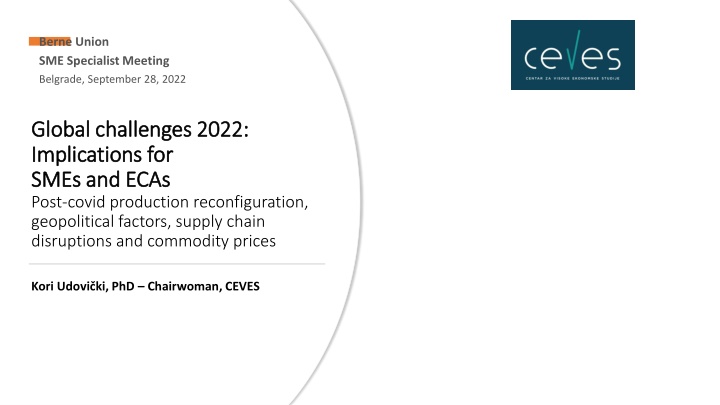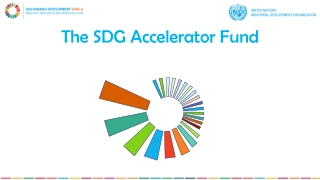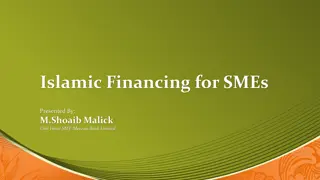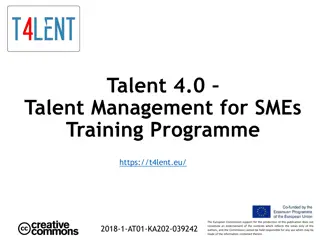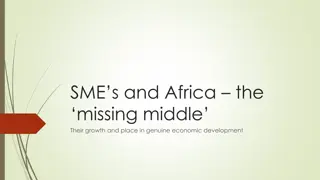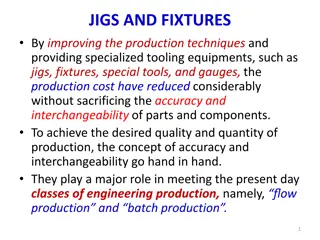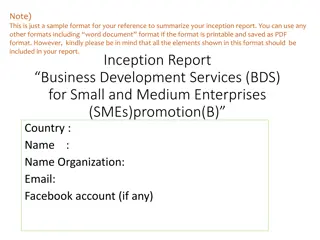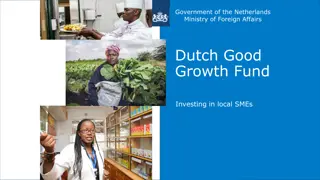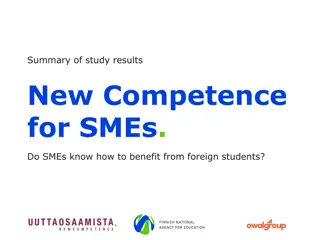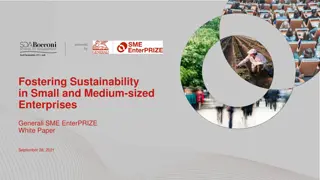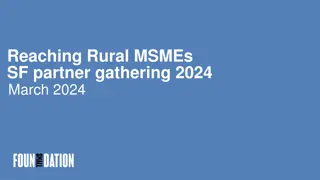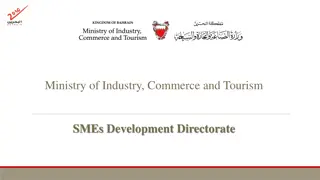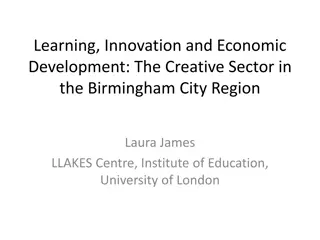Global Challenges 2022: Implications for SMEs and ECAs Post-COVID Production
The ongoing reconfiguration of global production intensified by the pandemic offers more opportunities than risks for SMEs. Policy implications include efforts to internationalize SMEs with a focus on understanding supply chain factors. Lessons from the pandemic highlight the importance of resilience vs. efficiency, leading to de-risking value chains and production dispersion strategies.
Download Presentation

Please find below an Image/Link to download the presentation.
The content on the website is provided AS IS for your information and personal use only. It may not be sold, licensed, or shared on other websites without obtaining consent from the author.If you encounter any issues during the download, it is possible that the publisher has removed the file from their server.
You are allowed to download the files provided on this website for personal or commercial use, subject to the condition that they are used lawfully. All files are the property of their respective owners.
The content on the website is provided AS IS for your information and personal use only. It may not be sold, licensed, or shared on other websites without obtaining consent from the author.
E N D
Presentation Transcript
Berne Union SME Specialist Meeting Belgrade, September 28, 2022 Global challenges 2022: Global challenges 2022: Implications for Implications for SMEs and ECAs SMEs and ECAs Post-covid production reconfiguration, geopolitical factors, supply chain disruptions and commodity prices Kori Udovi ki, PhD Chairwoman, CEVES 1
I The ongoing reconfiguration of global production... started before the pandemic (factors) the pandemic intensified it... and probably offers more opportunities than risks for SMEs. What I will say today: II The Russo-Ukrainian war... exacerbated threat of recession underscores importance of green transition likely to impact SMEs less than large companies. III Policy implications: Efforts to internationalize SMEs should be redoubled with much greater focus on understanding factors of supply
I - Reconfiguration of Global Production
A reversal in globalization was probably already under way before the pandemic Graph 1: The long-term trend of international production For 2 decades, globalization advanced Since GFC, FDI and trade have only kept pace with GDP (Share of GVC in trade - stagnant or declining) Share of SMEs in exports of 32 countries, 2008-2019 (OECD data) o Increased from 37% to 43% on average o 22 countries increasing trend, 10 declining Source: UNCTAD World Investment Report, taken from Center for Economic Policy Research (CEPR)
The very drivers of globalization now may foster its reversal Technological change at first unambiguously led to decentralization of production (value chains replaced of factories)... - digitalization (remote communication and process control, separation of services from production process) ...but its further progress reinforced reshoring potential - advanced robotics: strong reason for reshoring - additive manufacturing: potentially mass customization - bio- and other- technologies: hard to tell Wage differentials and growing productive capacity in outsourcing destinations... worked to increase the geographic spread of GVC... ...now the differentials are shrinking.
Lessons from the pandemic are a mixed bag Pandemic underscored the importance of resilience v. efficiency leading to efforts to: de-risk value chains with largely re-centralizing effects Shortening VC length Re- /Near- shoring (reducing distance) Greater transparency of VC (digitalization) and other processes likely to encourage production dispersion Diversification of suppliers Digitalization (greater flexibility of work organization)
So far mindsets seem to have changed more than flows First the global financial crisis showed the fallibility of markets => opened door for moreintervention (World Bank now supports industrial policy!) Then geopolitics provided a new impetus o Moreprotectionism US-China Trade war, EU-back to industrial policy o Regional, bilateral and ad hoc trade agreements But so far both FDI and trade have more than recovered--now stand above pre- pandemic levels o Decreased container shipping costs and the ongoing improvement of technologies continue to favor long-distance trade (during pandemic trade traversed longer distances!) Note: changes in the trade structure caused by the pandemic in a single year was similar to changes typically seen over 4-5 years
Expected mid-to- long- term outcomes Shortening of value chains and increased concentration of production Shrinking pool of efficiency seeking FDI (tougher competition to attract them) Strengthening of regional markets and clustering Diversification (opportunity) especially at the regional level Smaller-scale and flexibility favored Value chains increasingly rely on digital infrastructure and platforms
Impact on SMEs: probably more opportunities than risks Shortening of value chains: - Supplies produced in smaller series more likely to be reshored - esp. if 3D-printing reduces need for outsourcing of customization Regionalization + Smaller distances and series / clustering work in favor of SMEs Diversification + Doors open where it may not have been expected (a stretch) Smaller-scale and flexibility + Self-evident Reliance on digital infrastructure - Platforms themselves (very) large + May favor bottom-up access to GVC
II -The Russo- Ukrainian War
Skyrocketing energy and other commodity prices In the shorter run, Russo- Ukranian war is contributing to supply challenges, inflation, (recession?) Graph 2: Primary commodities prices indices 2011-2022 m7 Source: IMF
In the shorter run, Russo-Ukranian war contributing to supply challenges, inflation, (recession?) Energycosts overall 90% (July 2022 - July 2021) Gas prices skyrocketing, 5-10x increase (in Europe and Asia) on year before => Fertilizerprices 70% => Food prices 10% Russia and Ukraine account for more than 25% of the world s trade in wheat, 60% of global sunflower oil and 30% of global barley exports delayed and partly will not be realized Supply of strategic raw materials at risk => Aluminium, nickel, potash, palladium, vanadium
Commodity price: Impact on SMEs All else equal, shocks will have a stronger impact on SMEs o Fewer resources to: diversify inputs change technologies endure losses o Less bankable SMEs will be particularly affected by food production cost squeeze o (while opportunities to fill gaps in cereal production favors larger producers) But less by gas prices affect sectors with few SMEs (cement, fertilizer)
III - Policy Implications
A moment of massive structural change is rife with both with risks and opportunities Policy-makers attention is increasingly drawn towards a looming recession But a massive change in supply-side risks and opportunities is under way -- evidenced in ongoing supply value chain disruptions o Changes in demand structure, eg. for increased digitization, electric vehicle production, online orders increase in demand for chip production creating backlogs increase in demand for transportation and shipping services, also backlogs decline in demand for office space o Tech. changes and the greening imperative continuously offering opportunities My opinion: a race to make up for 4 years of structural change is what is holding the bottom of the global economy from falling out
ECAs should care about encouraging the internationalization of SMEs SMEs are key: o for spreading the benefits of economic growth over 50% of business sector employment, over 40% of VA, and 30% of exports o for innovation o to seize some of the opportunities offered by new circumstances o to growing national (as opposed to domestic) private sector income ohealthy political economies SMEs benefit from internationalization Only path to sufficient growth in most manufacturing sectors Increases their access to technology and competitiveness
Policy matters to internationalization of SMEs Graph 3: Direct SMEs Exports, share in total v. population size - EU member and accession countries, 2019 100% CY in line with hyperbolic fit High outliers Low outliers 90% 80% SMEs share in total export XK 70% 60% LV NL FI IT HR LU 50% BA PT SI 40% LT AT BE ES TR DK CH BG RS GR SW IS 30% PL SK CZ RO IE HU 20% DE FR 10% 5,5 6 6,5 7 7,5 8 Population (log of millions) Source: Eurostat Smaller countries tend to have a higher share of SMEs in exports Outliers can be explained by structure and policy
Rebalance policy efforts: from attraction of FDI towards more promotion of SMEs Pool of efficiency seeking FDI is likely to shrink (assuming GVC reconfiguration as expected) Not about protection, or subsidies (mostly not allowed), but about fostering a knowledge- and supportive services-rich environment tighter competition to attract them likely to result in regional race to the bottom Example: countries in the Western Balkans
Key: build knowledge on risks and opportunities for SMEs amid change in production structures Greater knowledge facilitates: => targeted investment in supportive environment (building the right capacities) => less transaction costs in assessing risk => further reach and coverage => more pooling of risk. Publicly supported gathering and (international) exchange of SME sectoral, business and tech intelligence would go a long way. Large companies make decisions based on consultancy information. (We learn from them as well: eg. (AlixPartners) estimated: in 2021 automotive industry lost more than $200 billion due to semiconductor chip shortage; SMEs cannot afford consultancies. Resources need to be dedicated, accumulating experiential knowledge over time, esp. for developing countries (can learn from each other)
Thank you for your attention! kori.udovicki@ceves.org.rs office@ceves.org.rs
